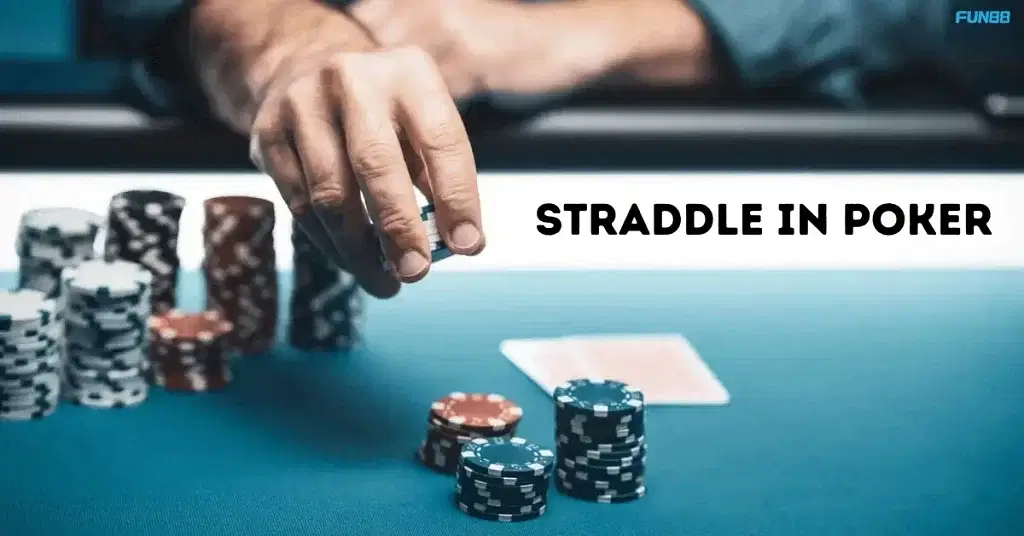Poker is a game where strategy, psychology, and a bit of luck meld into an exhilarating experience. As with many games deep in strategy, certain advanced plays can alter your approach, adding layers to your implementation. One such move is the straddle in Poker. For those getting into more severe play, understanding when and why to straddle—or why not—can be a game-changer.
What is a Straddle in Poker?
A straddle in Poker is a voluntary blind bet made by a player sitting directly to the left of the big blind, often double the amount of the big blind. The straddle turns the game into a pot-limit setting pre-flop, adding complexity and intrigue. This betting manoeuvre seeks to induce more action but necessitates careful consideration.
The essence of a straddle revolves around creating a higher initial pot and increasing potential gains, although it carries inherent risks. It alters the table dynamics, often escalating the stakes and strategies for all players. Those who employ straddles aim to either confuse opponents or capitalise on perceived advantages in understanding such table dynamics.
While common in live cash games, straddling is more irregular in Poker tournaments, and the rules around it can differ based on casino specifics or home game variations. Mastering this tactic involves understanding when its unpredictable nature benefits your strategy or when it might unnecessarily drain resources.
Advantages of Straddling

Straddling can offer several distinct advantages, particularly in live cash games where players seek to maximise gains and manipulate standard gameplay dynamics. Here are some reasons players may opt to straddle:
Increasing Pot Stakes from the Outset
One primary benefit of straddling is instantaneously boosting the pot size, setting a tone for higher-stakes engagement right off the bat. Players who thrive on high variance may find this prospect appealing, as it promises greater rewards should their strategy prevail.
Creating Psychological Pressure
Straddling adds an element of psychological warfare, potentially disrupting opponents’ usual gameplay rhythm. By altering the betting landscape, straddlers can exploit opponents less adept at adjusting to this heightened environment, capitalising on hesitation or errors.
Gaining Positional Advantage
For seasoned players, an unconventional tactic like the straddle opens avenues for exploration beyond standardised game tutorials. Going from risky to decisive, it elevates positional leverage post-flop. Since post-straddle players must act first, seizing the initiative allows efficient aggression or evaluation.
Fostering an Aggressive Table Image
A successful application of straddling fortifies an aggressive stance, unsettling others and promoting more caution or similar counter-aggression. This tactic can intimidate or cajole opponents into costly miscalculations in competitive surroundings, nurturing a favourable overall narrative.
Related Read: 10 Expert Tips to Become a Poker Expert: Level Up Your Skills
When to Avoid Straddling
Understanding circumstances where straddling could veer towards an unnecessary gamble enhances your decision-making arsenal. Here’s when straddling might not sync with the prevailing conditions:
Facing Tough Opponents
Aggressive or unpredictable play yields mixed results against seasoned strategists adept at counter-tactics. Refined adversaries excel at discerning nuanced decision-making and resisting provocation designed to upend their intellect.
Possessing Limited Bankroll
Financial prudence is paramount during fluctuating circumstances. If bankroll reserves appear insufficient to absorb losses without meaningful impact, forgoing straddles assures continued engagement. Gradual steps remain wiser than sweeping manoeuvres that endanger stability.
Post-Tilt Instability
During tilt periods when emotions compromise logic, discretionary refusals prevent further depletion. Subdued thoughts hinder reverting to equilibrium, so conservative assessments thwart incurring post-altercation traumatic decision-making.
Predictable Environment
Surprisingly, straddling when gameplay sags predictably risks complacency, fostering over-familiarity. Excessively intuitive moves avoid dynamic rebirths capable of reigniting productive variances across tablescapes, potentially triggering stagnation.
Crafting a Considered Approach to Straddling

Successful straddlers prepare intelligently by adopting holistic frameworks balancing quantitative acumen and qualitative foresight. Key themes accentuate the potential of skilled straddling:
Assessing Table Dynamics
Submerge yourself in the intricacies of opponent dynamics. Observe behavioural trends, perceive verbal/non-verbal cues, and align decisions with fluctuating route maps. Whether defensively responding to assertiveness or strategically escalating pot potential, balance highlights adaptability.
Calculating Optimal Timing
Harbour patience before instigating a straddle against seemingly random forces. Calculate the propensity for opponents to react favourably. Consider infrequent applications for maximum effect, surprising rivals accustomed to static environments.
Reflecting Personality Types
Accommodate the spectrum of human attitudes represented within poker. Adjust aggression models by recognising impulsive igniters or composure guardians. Selectively embracing straddling refines pre-round postures for collaborative output.
Embracing Flexibility
Versatility characterises minimalist opportunities:
- Withdraw at high-risk junctures.
- Embrace variable manoeuvrability regardless of context.
- Modify adjustments efficiently amid turbulent settings.
- Gracefully accept inconsistent outcomes.
Holistic Charting
Consider evolving straddling habits into broader context usage, balancing storylines across session archives while adapting confidently and cohesively. Formulate plot points that lead organically toward goal-stepping transformations, enhancing accumulated insights.
Also Read: What is Full House Poker Hand Ranking? Definition & Usage
Mistakes to Avoid in Poker Straddling
While the straddle in Poker can be an effective tool when wielded wisely, it is also prone to misuse, leading to costly missteps. Novice players and seasoned pros must stay vigilant against typical pitfalls to maximise their strategic advantage.
One of the most common mistakes is straddling indiscriminately without considering the specifics of the table dynamics. Each table is unique, with players displaying varying levels of aggression, skill, and strategy. Straddling blindly without accounting for these variables can quickly lead to an unfavourable position. It’s vital to consider who benefits most in a raised-stakes scenario. Suppose you’re at a table with predominantly tight players who are unlikely to give away chips easily. In that case, straddling might play into their cautious hands, rendering your move futile or even detrimental.
Moreover, overusing the straddle can erode its tactical value. Straddling too frequently shifts the balance from a strategic play to a predictable pattern opponents can easily counter. It can also lead to significant bankroll depletion if the cards or the situation suits you better.
Maintaining an element of unpredictability is essential to ensuring that when you do straddle, it catches players off guard and seizes control of the game’s momentum.
Emotionally driven straddling is another critical error. Playing from a place of tilt or frustration often leads to reckless decision-making, which can compound losses when coupled with the inherent risk of a straddle. Ensuring mental clarity and emotional control while making aggressive plays prevents impulsive strategies that rarely pay off long-term. Finally, misunderstanding the stakes is a significant error.
A straddle bet effectively increases the game’s stakes, creating a pseudo-blind level that requires more significant capital reserves. Faltering here could translate to a financial deficit, directly impacting your ability to keep playing. An informed approach—grounded in reading the room, paced usage, controlled emotions, and mindful bankroll management—is the golden rule to avoid pitfalls while straddling.
Also Read: Turn Poker Positions Into Winning Moves—Here’s How!
Conclusion: A Balanced Perspective
The straddle in poker is a remarkable strategic tool that is pivotal when employed under the appropriate conditions. While invoking partnerships among favourable alignments maximises efficiency, recognising risks sustains more extended engagement.
Navigating this path requires balancing exploration and caution—measured decision-making ensures continued advancement without unnecessary setbacks.
Harness the immense potential, bolster skill sets through application, and ultimately benefit substantially from engagement within poker’s multifaceted milieu.
Refer A Friend Get Rs1000 Instant Cash
Frequently Asked Questions (FAQs)
The straddle acts as a voluntary blind that can increase pot size and create higher stakes right from the start. It also aims to introduce a layer of dynamic unpredictability to the game.
Straddling can be risky, making it less suitable for beginners. Novices should thoroughly understand basic strategies and bankroll management before experimenting with straddling.
Straddling frequently inflates the pot size and can create aggressive table dynamics, leading to intensified betting behaviour and potentially shifting the game’s strategic flow.
While commonly used in cash games, straddling is rare in tournament settings due to structured blind increases and emphasis on controlled bankroll management in tourney formats.
Straddling increases the game’s stakes, requiring a thicker bankroll. Unsuccessful use can rapidly deplete resources, necessitating careful consideration of risk and reward balance.
Star it if you find it helpful.

